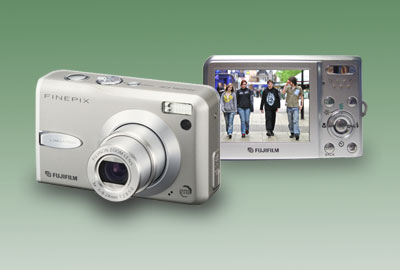
Up until last Friday I possessed two cameras. My 'proper' camera is a Sigma SD9, a bulky and unsophisticated digital SLR with one saving grace, its Foveon image sensor, which is capable of recording some of the most beautiful digital images I have seen from any digital camera.
Because of its bulk (especially when combined with an extra lens, batteries, chargers, flash attachment...) I don't carry the Sigma with me everywhere I go. This job was (until last Friday) taken by a Pentax Optio 555, a chubby but portable camera with a decent lens and CCD. For the last 18 months it has gone everywhere with me. I was so happy with it that when I went on holiday to Crete with my kidz last summer, I left the Sigma at home. There were a couple of occasions when I wished I had taken the Sigma, but the images the Pentax recorded will provide me with perfectly acceptable memories of our time in Greece.
 The Optio 555 has some major failings. Its start up time is slow (up to 6 seconds) and its 'shutter lag' (the time taken between pressing the button to take a photo and the photo actually being taken) has meant that I've missed capturing a number of shots. And while the images it captures are excellent, this only occurs when its CCD's sensitivity is set to ISO 64, the equivalent of having a 'slow' film in a conventional camera. This means that taking hand-held pictures in anything other than bright daylight is problematic.
The Optio 555 has some major failings. Its start up time is slow (up to 6 seconds) and its 'shutter lag' (the time taken between pressing the button to take a photo and the photo actually being taken) has meant that I've missed capturing a number of shots. And while the images it captures are excellent, this only occurs when its CCD's sensitivity is set to ISO 64, the equivalent of having a 'slow' film in a conventional camera. This means that taking hand-held pictures in anything other than bright daylight is problematic.However, up until recently, there hasn't been anything else that was 'better-enough' to justify trading it in. I looked at some of the new Pentax and Nikon compacts, but their speed and light-sensitivity weren't that much better. Casio and Fuji offerings were faster, but the image quality was suspect.
The Fujifilm F30 was announced earlier this year, and its selling points were clear... up to ISO 3200 light-sensitivity, ultra fast start-up speed with imperceptible 'shutter lag', all in a small form-factor with a huge, bright LCD, and excellent battery life. It became available in the UK last week. I purchased one last Friday.
It looks beautiful, the design is elegant, yet robust, with the two main niggles being the fragile, fiddly plastic cover for the USB and power sockets, and the plastic tripod thread.
The LCD screen is so clear and bright (when you select the 60 frames per second refresh rate) that the lack of an optical viewfinder is not missed, and the menu system is ugly but well thought out, with the most used functions available via buttons on the rear of the camera.
Focussing is fast and accurate, even in very low-light... which is fortunate, as this is a camera that works in VERY low light. Indoor and evening pictures can be achieved without flash, allowing natural-looking shots to be taken in nearly any situation, especially as the shutter-lag really is imperceptible, you press the button, and the picture is taken. There is even a superb function where you keep the shutter held down, and the camera takes a stream of pictures, only keeping the three just before you 'release' the shutter. Great for those 'waiting for something to happen' shots
But what about image quality?
First a 400 x 270 pixel crop of a shot taken with the Fuji at ISO 100.
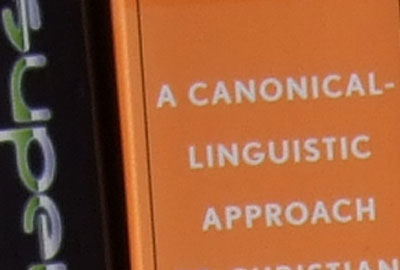
The Pentax at ISO 100 gives this result:

I prefer this image, there is more 'noise', but where the Fuji's processing 'flattens' the image, the Pentax's software retains the detail, making the edges of the text more 'real'.
However, when the ISO is cranked up to 3200 on the Fuji we get an image like this:

Detail has been lost, and there is a 'smearing' effect, but the image is still remarkably clear, especially when not viewed at such a revealing magnification.
The Pentax only goes up to an ISO 400 setting, but by underexposing two stops, then post-processing in Photoshop, I have mimicked an ISO value of 1600:

Noise is now extremely noticeable, and even at 'normal' magnifcations, the image appears 'harsh' and 'grainy'.
For a more 'real-world' shot, I arranged the following set:
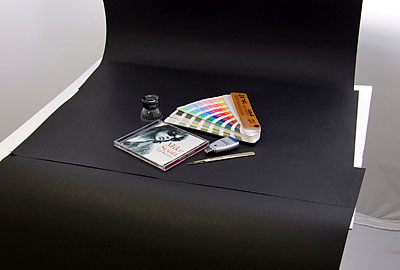
I then took a series of shots with the F30 at ISO 100, 800 and 3200, then cropped a 400 x 270 pixel section of each one:
ISO 100

ISO 800
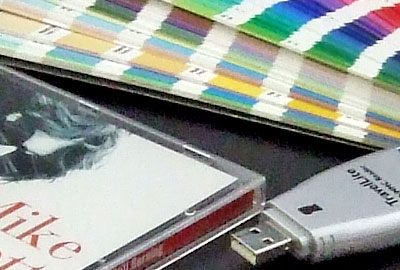
ISO 3200
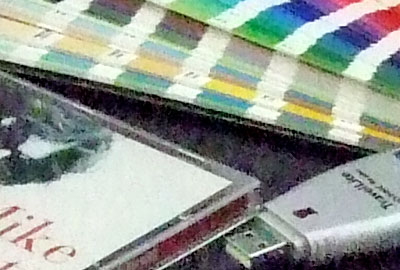
The progressive degradation in image quality on the two higher speed images is quite obvious, with the in-camera image-processing smearing the details. However, the fact that I can now take a blur-free, hand-held picture in nearly any situation more than outweighs this, and when the pictures are viewed in iPhoto, or on ink-jet prints, the 'digital cellulite' isn't nearly as noticeable.
As with all technology, the F30 isn't perfect. I wish I had some kind of control over the in-camera image-processing. The Optio 555 allows you to adjust sharpness, saturation and contrast. I'd have liked the option of RAW and TIFF formats, with the F30 all I get is two levels of JPEG compression.
However, I have to keep reminding myself that this is a credit card-size camera, weighing less than 200g, which is allowing me to record very acceptable images in just about any situation. The F30 is a keeper.
------------

5 comments:
its a pretty good camera for what it is, especialy good as far as I can see for portability. Although I wouldnt use it for anything more than snapshots - im too used to the excelent quality that my cannon 350D pumps out.
All in all good review.
The canon 350d is an ok camera... and the image quality far exceeds the fuji f30, but you'd get a lot more for your money buying a sigma sd10, the images are in a different class.
I guess we are now at the stage where we upgrade our cameras every two or three years, just like computers?
It always used to be that we would save up to afford a top of the range Nikon or Leica that would then last us for life, with the only extras being new lenses.
It would seem that the SLR is still king for quality, but something like the F30 seems to fill a really nice gap - professional and portable and small enough to take with you wherever you go.
It will be interesting to see how lens manufacturing continues to develop to see how 'professional' these little compacts can get.
Isn't it great to be alive in this age?
Also some high iso photo links (ISO 3200-400):
http://highiso.net/fuji/fujifilm-finepix-f30.html
thanks jani
b
Post a Comment